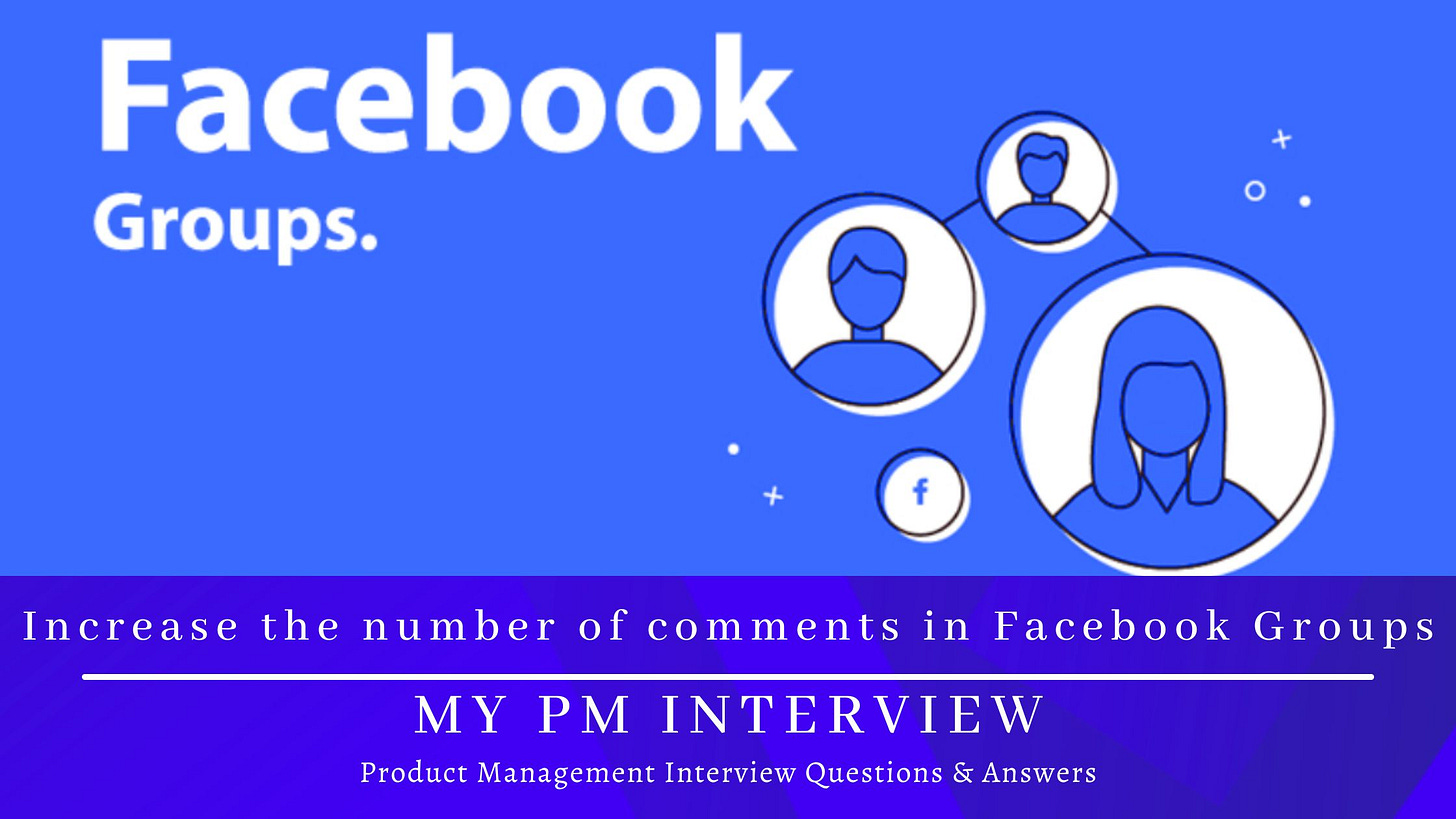Growth: Increase the Number of Comments in Facebook Groups
Meta Product Growth Interview : How would you increase the Number of Comments in Facebook Groups?
Describe the Product
Facebook Groups is one of Meta’s most powerful community-building tools, enabling users to connect, share, and engage around shared interests, geographies, life stages, or passions. With over 1.8 billion monthly users, Groups serves as a digital “town square” for millions of niche and mainstream communities.
At its core, Facebook Groups empowers users to:
- Post content (text, images, videos, links, polls, etc.)
- Discuss topics via comments and reactions
- Share events, documents, and live videos
- Create sub-communities (like Buy/Sell, Parenting, Alumni groups)
Groups can be public, private, or hidden, and cater to both casual and highly engaged communities.
While Facebook Groups are not directly monetized, they support:
- Retention and engagement across the Facebook app
- Community-driven commerce (e.g., Buy/Sell groups)
- Ad impressions when group content shows up in feeds
Competitors include Reddit, Discord, WhatsApp Communities, Slack (in professional contexts) and Telegram (global reach).
Clarifying Questions
Before jumping into solutions, ask the right questions to narrow the scope and avoid building for the wrong objective.
Here are the key clarifying questions I would ask:
Are we focusing on increasing organic engagement, enabling monetization for creators/admins, or monetizing Facebook itself through increased group activity?
A) Focus on increasing organic engagement (especially comments) from users, but feel free to explore solutions that indirectly enable monetization
Are we targeting specific group types — such as public groups, private groups, interest-based groups, or admin-run communities — or all types of Facebook Groups?
A) All types of groups are in scope.
Is there a specific user segment we should focus on — new users, lurkers, infrequent participants, or existing contributors?
A) Its upto you.
Are we optimizing for mobile, desktop, or both?
A) Prioritize mobile-first experiences.
Should we focus only on increasing comment quantity, or also the quality of those comments?
A) Focus primarily on comment volume, but quality should not degrade.
What is the timeline for impact — are we looking for short-term engagement wins or long-term retention strategies?
A) Explore both.
Define Core Goals
Based on the product context and clarifications, the primary goal is to increase the number of comments in Facebook Groups in a sustainable and meaningful way, focusing on driving deeper engagement from passive users while maintaining content quality, community trust, and mobile-first usability across diverse group types.
My approach now will be to identify key user segments, diagnose behavior and pain points, design features or incentives that drive organic commenting, prioritize ideas by impact and feasibility, and finally define success metrics aligned with group engagement, retention, and long-term platform health.
List User Segments
To design meaningful interventions that increase the number of comments in Facebook Groups, it's essential to understand the different user archetypes participating in group ecosystems:
1. Everyday Users
Who they are: Regular Facebook users who join groups for hobbies, neighborhoods, parenting, education, fitness, careers, or niche interests.
Behavior: They mostly browse, occasionally like or react to posts, and rarely comment unless prompted.
Motivation: Discover relevant content, stay updated, and feel part of a community.
Why they matter: They form the bulk of group audiences. Activating this silent majority is key to increasing comment volume at scale.
2. Content Creators & Power Contributors
Who they are: Individuals who post regularly—starting discussions, sharing insights, or asking questions.
Behavior: Frequently initiate conversations but may not receive enough responses, which discourages further posting.
Motivation: Build a following, gain recognition, or add value to the community.
Why they matter: Their posts seed engagement. A positive feedback loop (more comments = more posts) can drive sustained activity.
3. Group Admins & Moderators
Who they are: Users who create, moderate, and manage groups. They enforce rules, approve posts, and guide tone.
Behavior: Often focus on moderation and policy enforcement over participation.
Motivation: Grow healthy, vibrant, and respectful communities.
Why they matter: They shape group culture and can enable or inhibit commenting through design and community rules.
4. Brands & Organizations
Who they are: Businesses or NGOs that run groups for customer support, feedback, or brand building.
Behavior: Post content, reply to queries, and try to maintain a consistent presence.
Motivation: Improve engagement, build trust, and gather insights.
Why they matter: Comments on brand posts are valuable for both engagement metrics and feedback loops, and can help Facebook monetize group interactions via tools or ads.
Selected Segment to Prioritize:
Everyday Users — because they represent the largest cohort with untapped engagement potential. If we can convert even a small percentage of lurkers into commenters, the comment volume would significantly increase.
List down the User Pain Points
Considering the 'Everyday Users' segment—who mostly consume content passively in Facebook Groups—their key pain points around engagement and commenting behavior include:
Many users fear judgment or backlash for sharing opinions, especially in large or sensitive-topic groups, leading to hesitation in commenting publicly.
Group posts often feel informational or one-sided, without clear prompts or engaging questions that invite user participation through comments.
Commenting yields no visible reward—users don’t gain recognition, perks, or visibility for contributing thoughtful replies, making participation feel thankless.
In active groups, content is quickly buried under newer posts, which discourages users from commenting on anything that’s no longer “fresh” or trending.
When group feeds are cluttered with spam, promos, or off-topic posts, users lose interest in engaging, reducing the likelihood of thoughtful conversation.
Long, messy threads with hundreds of replies (especially with no threading or smart sorting) make it hard to join the conversation or feel heard.
Users who do comment often receive little to no acknowledgment—no likes, replies, or reactions—leading to low motivation to comment again.
If users don’t receive updates when others reply to their comments, conversations feel disjointed and users don’t return to keep engaging.
List down the solutions
Here are solutions for increasing the number of comments in Facebook Groups, based on the pain points of 'Everyday Users' segment:



